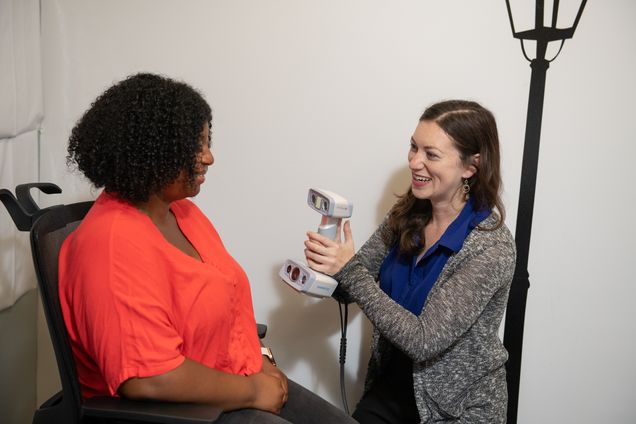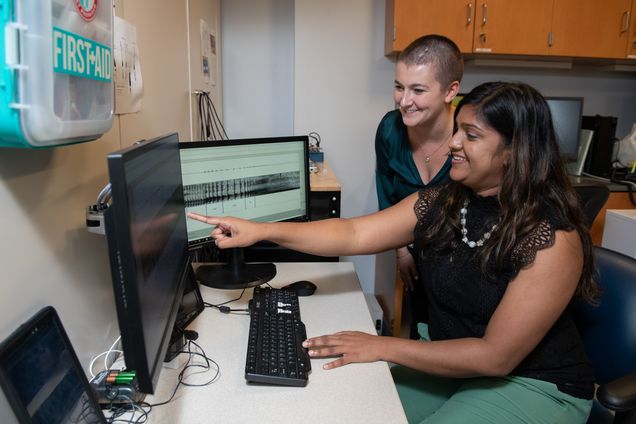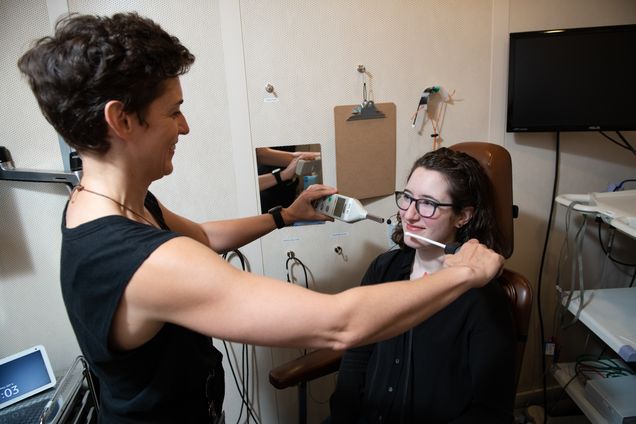Current Research
Gender-affirming Care for Communication:
 Members of the trans and gender-diverse community identify their speech as an important part of their gender expression. We examine gender-affirming speech care (hormonal and behavioral) and how this relates to satisfaction with speech production. For instance, gender-affirming hormone therapy with testosterone (T) is currently the default treatment for voice masculinization. However, there is very limited evidence about what individuals can expect on T and why. We are conducting a longitudinal observational study to systematically test what changes, when changes occur, and what might predict changes in trans and gender-diverse assigned-female-at-birth adults who are being treated with T as part of their typical clinical care over the course of year 1 of treatment. Our studies incorporate anatomical (structural magnetic resonance imaging), physiological (stroboscopy, aerodynamics), acoustical, and perceptual measures to provide baseline information about vocal function and allow for evidence-based voice care in this growing population. Our work is directly motivated by conversation and questions from members of the trans and gender-diverse community. We work in collaboration with a committee of gender-affirming healthcare experts and committee members to improve the specificity, inclusivity, and impact of our research.
Members of the trans and gender-diverse community identify their speech as an important part of their gender expression. We examine gender-affirming speech care (hormonal and behavioral) and how this relates to satisfaction with speech production. For instance, gender-affirming hormone therapy with testosterone (T) is currently the default treatment for voice masculinization. However, there is very limited evidence about what individuals can expect on T and why. We are conducting a longitudinal observational study to systematically test what changes, when changes occur, and what might predict changes in trans and gender-diverse assigned-female-at-birth adults who are being treated with T as part of their typical clinical care over the course of year 1 of treatment. Our studies incorporate anatomical (structural magnetic resonance imaging), physiological (stroboscopy, aerodynamics), acoustical, and perceptual measures to provide baseline information about vocal function and allow for evidence-based voice care in this growing population. Our work is directly motivated by conversation and questions from members of the trans and gender-diverse community. We work in collaboration with a committee of gender-affirming healthcare experts and committee members to improve the specificity, inclusivity, and impact of our research.
Acoustic Correlates of Typical and Disordered Speech:
 We have a long-term interest in understanding the relationship between acoustic parameters and the physiology of speech and voice variety of speech disorders (Parkinson’s disease, vocal hyperfunction, laryngeal dystonia). We measure kinematics (via electromagnetic a in articulography, respiratory plethysmography), subglottal pressure and airflow, sensory acuity, and surface electromyography in concert with acoustics and high-speed video recordings of the vocal folds during speech production (via nasal endoscopy). This work will help develop objective measures that can aid in clinical diagnosis, documentation of treatment response, and measurement of treatment efficacy of novel therapies in voice disorders. We also hope to compare longitudinal changes in patient-centered outcomes to longitudinal changes in speech physiology. For instance, individuals with laryngeal dystonia (also known as spasmodic dysphonia) often wait 5 years to receive an accurate diagnosis; once they have one, the gold-standard treatment is invasive injection of Botulinum toxin through the neck into the larynx several times a year to minimize symptoms. Developing ways to better measure the signs of laryngeal dystonia may lead to quicker and more accurate diagnosis. These measures may also serve to validate novel treatment options for laryngeal dystonia. Likewise, our work in Parkinson’s disease is focused on understanding how symptoms in different speech subsystems (respiratory, laryngeal, articulatory) may drive functional communication outcomes, with the long-term goal of developing clinically relevant measures that can identify the physiological bases of patient-specific speech impairment. These measures could then be used to tailor therapies to the specific needs of each patient.
We have a long-term interest in understanding the relationship between acoustic parameters and the physiology of speech and voice variety of speech disorders (Parkinson’s disease, vocal hyperfunction, laryngeal dystonia). We measure kinematics (via electromagnetic a in articulography, respiratory plethysmography), subglottal pressure and airflow, sensory acuity, and surface electromyography in concert with acoustics and high-speed video recordings of the vocal folds during speech production (via nasal endoscopy). This work will help develop objective measures that can aid in clinical diagnosis, documentation of treatment response, and measurement of treatment efficacy of novel therapies in voice disorders. We also hope to compare longitudinal changes in patient-centered outcomes to longitudinal changes in speech physiology. For instance, individuals with laryngeal dystonia (also known as spasmodic dysphonia) often wait 5 years to receive an accurate diagnosis; once they have one, the gold-standard treatment is invasive injection of Botulinum toxin through the neck into the larynx several times a year to minimize symptoms. Developing ways to better measure the signs of laryngeal dystonia may lead to quicker and more accurate diagnosis. These measures may also serve to validate novel treatment options for laryngeal dystonia. Likewise, our work in Parkinson’s disease is focused on understanding how symptoms in different speech subsystems (respiratory, laryngeal, articulatory) may drive functional communication outcomes, with the long-term goal of developing clinically relevant measures that can identify the physiological bases of patient-specific speech impairment. These measures could then be used to tailor therapies to the specific needs of each patient.
Speech Motor Control of Normal and Disordered Speech:
 Models of speech motor control help us better understand how individuals learn, maintain, and change their speech production. We are interested in understanding the relationship between auditory and somatosensory feedback and sensorimotor integration as it relates to voice and articulatory motor control in typical speakers and individuals with speech disorders (i.e., vocal hyperfunction, Parkinson’s disease, laryngeal dystonia). We measure sensory feedback, sensorimotor integration and sensory acuity in concert with acoustics, auditory-perceptual evaluations, arousal of the autonomic nervous system, respiratory kinematics, and the influence of a listener on speech adjustments. In neurological disorders such as Parkinson’s disease and laryngeal dystonia, this work can help to elucidate the mechanisms through which the disease affects speech, which can be used to design new treatments. Alternatively, this work can provide new insights about the nature of the disease process itself. For instance, vocal hyperfunction is the most common category of voice disorder, and it includes disorders such as vocal fold nodules, vocal fold polyps, and muscle tension dysphonia. Vocal hyperfunction is a disorder of vocal production, and patients often report increased laryngeal tension resulting in changes in voice quality, fatigue, and muscular pain, which can result in difficulty communicating in daily life. Vocal hyperfunction has classically been categorized as “functional”, with a focus on behavior and personality as driving factors in its development. However, our recent work has found that many patients with vocal hyperfunction have auditory and auditory-motor integration impairments. Our current work is continuing to investigate auditory-motor function in these individuals to understand how auditory function relates to the development and persistence of vocal hyperfunction. Our long-term goal is to develop more useful clinical assessments and treatment approaches.
Models of speech motor control help us better understand how individuals learn, maintain, and change their speech production. We are interested in understanding the relationship between auditory and somatosensory feedback and sensorimotor integration as it relates to voice and articulatory motor control in typical speakers and individuals with speech disorders (i.e., vocal hyperfunction, Parkinson’s disease, laryngeal dystonia). We measure sensory feedback, sensorimotor integration and sensory acuity in concert with acoustics, auditory-perceptual evaluations, arousal of the autonomic nervous system, respiratory kinematics, and the influence of a listener on speech adjustments. In neurological disorders such as Parkinson’s disease and laryngeal dystonia, this work can help to elucidate the mechanisms through which the disease affects speech, which can be used to design new treatments. Alternatively, this work can provide new insights about the nature of the disease process itself. For instance, vocal hyperfunction is the most common category of voice disorder, and it includes disorders such as vocal fold nodules, vocal fold polyps, and muscle tension dysphonia. Vocal hyperfunction is a disorder of vocal production, and patients often report increased laryngeal tension resulting in changes in voice quality, fatigue, and muscular pain, which can result in difficulty communicating in daily life. Vocal hyperfunction has classically been categorized as “functional”, with a focus on behavior and personality as driving factors in its development. However, our recent work has found that many patients with vocal hyperfunction have auditory and auditory-motor integration impairments. Our current work is continuing to investigate auditory-motor function in these individuals to understand how auditory function relates to the development and persistence of vocal hyperfunction. Our long-term goal is to develop more useful clinical assessments and treatment approaches.